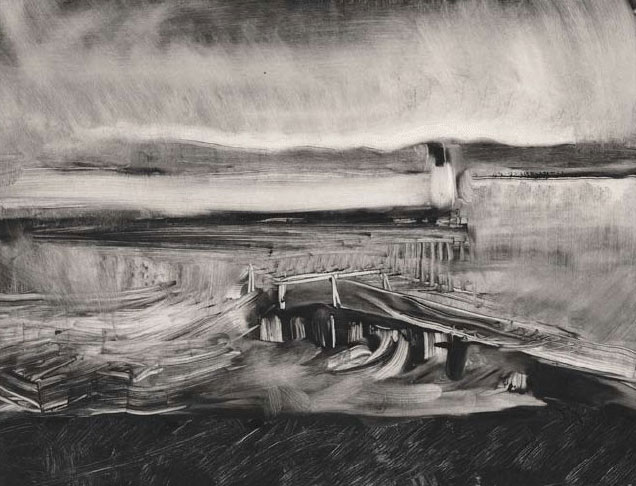- Relief printing
- Intaglio and planographic printing
- Color printing
- Bits and pieces
- Early photography in silver
- Non-silver processes
- Modern photography
- Color notes
- Color photography
- Photography in ink: relief and intaglio printing
- Photography in ink: planographic printing
- Digital processes
- Where do we go from here?
Monotypes

Monotype. Christopher Benson. View of Narragansett Bay. 1987. 9 x 11 3/4" (22.9 x 29.9 cm). The Museum of Modern Art, New York. Gift of Richard Benson © Christopher Benson.
Planographic printing can be done from an evenly smooth-surfaced printing plate with neither raised areas, such as we find in relief printing, nor low ones, as in intaglio printing. The most basic form of planographic printing is the monotype, which can most easily be described as printing from a finger painting done on a copper plate. The press is the same press used for intaglio printing and the plate is the same copper plate used in engraving and etching, because that is the kind of plate we find in printshops that have those presses. No work is done to the plate, though, except to make sure it is polished and to bevel the edges to avoid cutting the paper and felts during printing. If we smear ink on such a plate and run it through the press with dampened paper on top, the ink will transfer onto the paper.
It is surprising to find, though, that not all of the ink transfers; quite a lot is left on the plate. With no additional work to it, the plate can be printed again and a much lighter version of the print will appear. Despite the name of the process, then, we do find monotype editions, which the artist can make by repainting the plate after each impression, using the residue left on the plate as a guide for the new work. Every print in a monotype edition is unique, but all are related through the visual foundation maintained by the succession of pale residual ink images that act as guides to the artist doing the printing. This business of ink left on a plate is extremely important, affecting processes as simple as monotype and as complex as modern offset printing. In all print processes the signal conveyed from plate to paper is generated not only by ink applied for the present impression but by residues of ink left from earlier impressions. The plate prints a union of these inks, so it is obvious that the first impression of any plate cannot represent what the plate will do when printed in an edition. This sounds like a minor point, but it is central to the practice of printing in multiple copies. The simple monotype brings to light some of the complexities of printing plates and the manner in which they transfer ink to paper.

